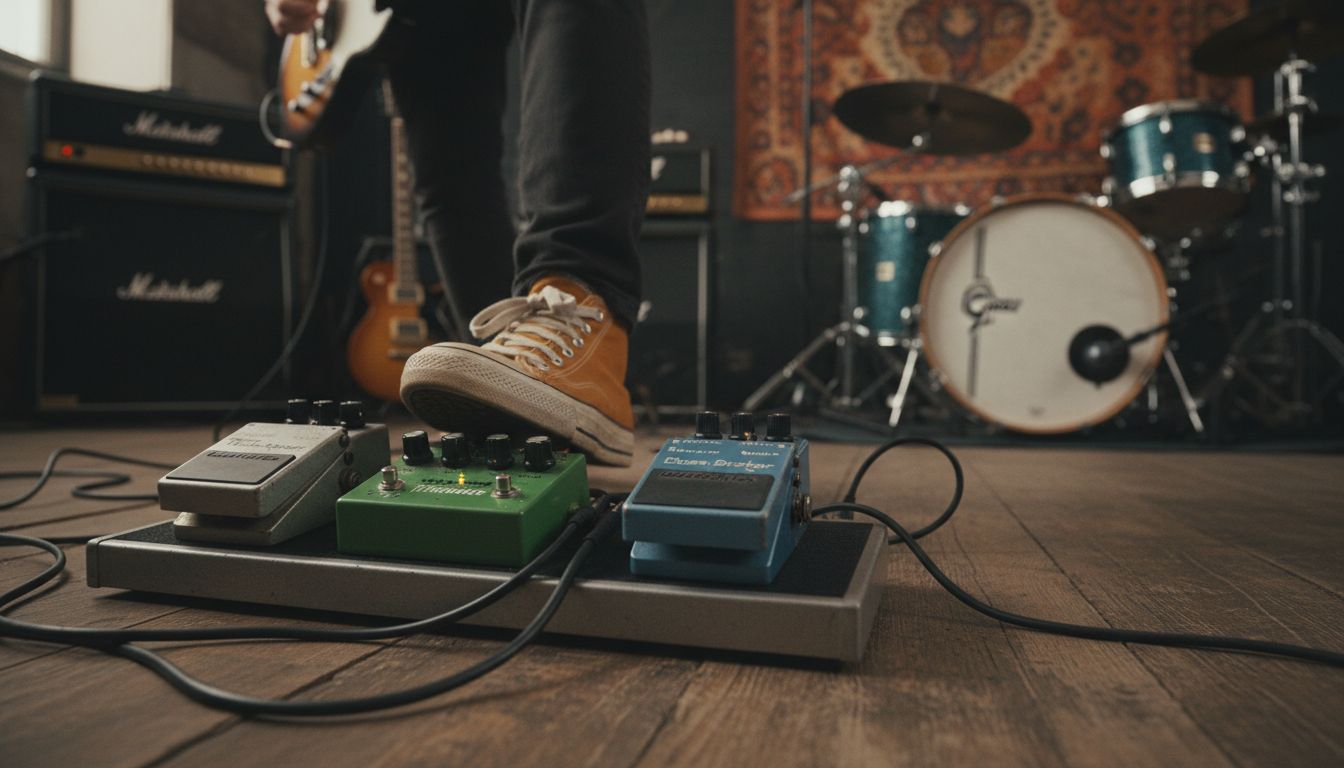Did you know that overdrive pedals have shaped the sound of popular music for over four decades? Guitarists around the world rely on this unique effect to add warm grit and vibrant character to their playing. Overdrive bridges the gap between clean tones and full distortion, helping musicians express emotion and create signature sounds that set them apart on stage and in the studio.
Table of Contents
- Defining Overdrive In Guitar And Music
- Types Of Overdrive Pedals And Circuits
- How Overdrive Affects Guitar Tone
- Key Applications And Settings For Musicians
- Overdrive Vs. Distortion And Fuzz Effects
Key Takeaways
| Point | Details |
|---|---|
| Overdrive Definition | Overdrive is an electronic effect that replicates the natural saturation of a pushed amplifier, creating a warm, dynamic tonal character between clean and distorted sounds. |
| Types of Overdrive Pedals | Iconic overdrive pedals like the Ibanez Tube Screamer and Marshall Blues Breaker offer distinct tonal characteristics, appealing to various musical genres. |
| Tonal Transformation | Overdrive introduces harmonic distortion that enriches guitar tones, allowing for expressive play through careful gain and tone adjustments. |
| Comparison with Distortion and Fuzz | Overdrive provides subtle signal modification, while distortion and fuzz push signals into aggressive territories, offering distinct sound profiles for musicians to explore. |
Defining Overdrive in Guitar and Music
In the world of guitar playing, overdrive represents a transformative sound effect that breathes life into musical performances. According to research from guitar audio experts, overdrive is an electronic technique designed to replicate the natural saturation of a guitar amplifier pushed to its sonic limits, creating a warm, dynamic tonal character that sits perfectly between clean playing and full distortion.
At its core, overdrive generates what musicians call a “crunch” tone - a slightly gritty, compressed sound that emerges when an amplifier’s signal is intentionally pushed beyond its standard operating range. This effect essentially mimics the natural breakup that occurs when vintage tube amplifiers are driven hard, producing harmonically rich overtones that add depth and intensity to guitar sounds. From Good to Great: Your Sound; 3 Essential Pedals for a Function Band explores how effects like overdrive can dramatically enhance musical performances.
Unlike full distortion, overdrive offers a more subtle and nuanced approach to signal modification. The effect typically provides less aggressive gain, allowing guitarists to maintain note definition while introducing textural complexity. Musicians across genres from blues and rock to country and indie frequently utilize overdrive to add emotional intensity and dynamic range to their playing, transforming ordinary guitar sounds into something extraordinarily expressive.
Types of Overdrive Pedals and Circuits
The world of overdrive pedals offers guitarists a diverse range of sonic possibilities, with classic designs that have shaped musical genres for decades. According to research from guitar equipment experts, two iconic overdrive circuits stand out: the Ibanez Tube Screamer and the Marshall Blues Breaker. These pedals have become legendary for their distinctive tonal characteristics and ability to transform guitar sounds.
The Ibanez Tube Screamer represents a quintessential overdrive circuit, renowned for its distinctive mid-heavy tone and soft clipping characteristics. This pedal style produces a compressed, tight sound that cuts through mix environments, making it particularly popular in blues, rock, and metal genres. Musicians often use the Tube Screamer to push their amplifiers into natural breakup, creating a harmonically rich sound that adds significant character to guitar tones. The Basics of Pedalboards and How to Build Your Own System provides excellent insights into integrating such classic pedals into your rig.
In contrast, the Marshall Blues Breaker overdrive offers a more transparent and amp-like approach. This circuit is characterized by its open, dynamic sound that emulates the natural overdrive of a vintage Marshall amplifier. Unlike the Tube Screamer’s mid-focused tone, the Blues Breaker provides a more balanced frequency response, allowing guitarists to retain more of their instrument’s original character while adding a smooth, musical compression. Different overdrive pedals essentially serve as sonic paintbrushes, enabling musicians to craft unique tonal textures that range from subtle warmth to aggressive crunch, making them essential tools for expressive guitar playing.

How Overdrive Affects Guitar Tone
Overdrive fundamentally transforms the guitar tone by introducing controlled harmonic distortion that adds depth, warmth, and character to the instrument’s sound. According to research from musical equipment experts, overdrive is achieved by intentionally increasing the gain of the preamplifier beyond standard levels, creating a gritty and slightly compressed sonic texture that musicians find incredibly expressive.
In practical application, overdrive acts like a sonic magnifying glass, highlighting the nuanced characteristics of both the guitar and amplifier. When applied to a clean amp, it generates a warm, powerful sound that can range from subtle warmth to aggressive edge. Blues and rock guitarists particularly appreciate how overdrive can breathe life into their playing, adding complexity and emotional intensity to each note. Electric Guitar and Amp Duos That Will Blow Your Mind explores how different amplifier and overdrive combinations can dramatically reshape musical expression.
The tonal manipulation of overdrive goes beyond simple volume boost. It introduces soft clipping and harmonic enrichment, essentially creating a more complex waveform that sounds fuller and more interesting than a pure, clean signal. By carefully adjusting gain levels, guitarists can dial in everything from a gentle tube-like breakup to a more pronounced, saturated sound that pushes the boundaries between clean and distorted tones. This incredible versatility makes overdrive an essential tool for musicians seeking to express themselves with greater tonal depth and emotional range.
Key Applications and Settings for Musicians
Understanding the strategic settings of overdrive is crucial for musicians seeking to unlock the full potential of their guitar tone. According to research, overdrive can be applied across multiple contexts, from boosting a clean amplifier to enhancing an already saturated sound, making it an incredibly versatile tool for guitarists across various genres.
For blues and rock musicians, overdrive settings typically involve careful gain manipulation to achieve the perfect balance between clean articulation and harmonic richness. Complete Guide to Professional Guitar Setups highlights the importance of nuanced tone control. Guitarists can experiment with three primary overdrive approaches: subtle boost, which adds warmth without significant distortion; mid-gain crunch, providing moderate saturation and increased harmonic complexity; and high-gain drive, creating more aggressive, compressed tones ideal for harder rock and metal styles.
Practical application requires understanding how different amplifier characteristics interact with overdrive settings. Musicians should focus on key parameters like gain level, tone control, and volume compensation. By incrementally adjusting these settings, guitarists can discover unique sonic textures that complement their playing style. The magic of overdrive lies in its ability to transform a standard guitar signal into a rich, expressive voice that communicates emotion beyond mere notes - turning technical playing into a deeply personal musical statement.
Overdrive vs. Distortion and Fuzz Effects
The world of guitar effects presents a nuanced spectrum of sound manipulation, with overdrive, distortion, and fuzz representing distinct approaches to signal transformation. According to research, these effects differ fundamentally in how they modify the guitar’s electrical signal, creating unique sonic characteristics that musicians carefully select to express their musical voice.
5 Kinds of Fuzz Pedals You Should Consider Getting highlights the diverse landscape of guitar effects. Overdrive represents the most subtle of these techniques, gently pushing the signal’s amplitude non-linearly and typically adding even harmonics. This creates a warm, tube-like sound that mimics an amplifier on the edge of breakup. In contrast, distortion is more aggressive, sharply clipping the signal wave at peak levels and introducing predominantly odd harmonics. This results in a more compressed, intense sound that dramatically alters the original signal.
Fuzz takes signal modification to its most extreme form, essentially transforming the guitar’s tone into a nearly square wave that produces a thick, synth-like quality. While overdrive aims to recreate the natural saturation of a guitar amplifier with minimal gain, distortion and fuzz push the signal into more radical sonic territories. Each effect offers musicians a unique palette of tonal options - from the gentle warmth of overdrive to the raw, aggressive character of fuzz - allowing for incredible expressiveness and emotional depth in musical performance.
Here’s a comparison of the main characteristics of overdrive, distortion, and fuzz effects:
| Effect Type | Signal Clipping Style | Harmonic Content | Typical Tonal Quality |
|---|---|---|---|
| Overdrive | Soft clipping | Even harmonics | Warm, dynamic |
| Distortion | Hard clipping | Odd harmonics | Compressed, intense |
| Fuzz | Extreme clipping | Mixed harmonics | Thick, synth-like |
Unlock the True Potential of Your Guitar Tone with Expert Overdrive Gear
Struggling to capture that perfect warm, dynamic overdrive sound that brings your guitar playing to life? Whether you want the iconic crunch of the Ibanez Tube Screamer or the smooth saturation of a vintage Marshall Blues Breaker, finding the right pedal and gear setup is crucial. The article highlights how overdrive pedals add emotional depth and harmonic richness, but without premium equipment, achieving that expressive tone can remain a challenge.
At MusicStreet, we understand the journey to your ideal guitar tone starts with quality instruments and carefully selected effects pedals. The Basics of Pedalboards and How to Build Your Own System will guide you through assembling a setup that unlocks new sonic textures. Plus, explore our versatile range of handpicked guitars and overdrive pedals designed to help you control gain levels and tonal nuances with ease.

Ready to transform your playing with overdrive tones that truly express your musical voice? Visit MusicStreet now to explore premium pedals and expert advice to elevate your sound today. Don’t miss out on capturing that rich, harmonically complex tone that lets your guitar speak with passion and precision.
Frequently Asked Questions
What is overdrive in guitar playing?
Overdrive is a sound effect that simulates the natural saturation of a guitar amplifier when it is pushed to its limits, creating a warm and dynamic tonal character between clean and distorted sounds.
How does overdrive differ from distortion and fuzz?
Overdrive features soft clipping and predominantly even harmonics, producing a warm, dynamic tone. Distortion applies hard clipping with odd harmonics for a compressed and intense sound, while fuzz creates an extreme clipping effect resulting in a thick, synth-like tone.
What are the best settings for using an overdrive pedal?
Optimal settings depend on the style, but general approaches include subtle boost for warmth, mid-gain crunch for harmonic complexity, and high-gain drive for aggressive tones. Key adjustments involve gain level, tone control, and volume compensation to complement your playing style.
Why do guitarists use overdrive?
Guitarists use overdrive to add emotional intensity, dynamic range, and tonal complexity to their playing. It enhances the characteristics of both the guitar and amplifier, turning standard signals into rich, expressive sounds.




Share:
Celebrating Famous Bass Guitarists Who Shaped Music History
7 Essential Tips for Using Electric Guitar Pedals Effectively